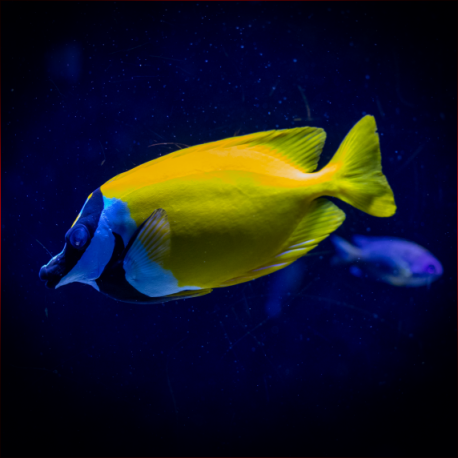More info
Datasheet
| Minimum Tank Size | 700 litres / 184.92 US gallons |
| Maximum Size | 20.0cm / 7.87inches |
| Reef Compatible | Often reef safe |
| Temperament | Mostly peaceful but might be aggressive towards similar species |
| Temperature | 22.2°C / 71.96°F - 25.6°C / 78.08°F |
| Specific Gravity | 1.020-1.025 |
| Carbonate Hardness | 8-12 |
| pH | 8.1-8.4 |
General Description
The Foxface, scientifically known as Siganus vulpinus, belongs to the Siganidae family and is recognized for its role as an effective algae eater in aquariums. These fish, also called Rabbitfish, are equipped with toxic spines on their backs, emphasizing the need for caution when handling them. They have the ability to change color and pattern when feeling threatened, often camouflaging themselves against rocks.
Aquarium Suitability
Considered suitable with care, Foxface fish require a tank of at least 700 liters due to their active swimming nature. They are not recommended for small aquaria as they can exhibit repetitive behavior if confined in limited spaces. It's crucial to provide a well-established aquarium with ample algae growth for grazing, supplemented by an algae-based diet to maintain their health.
Demands, Care, and Hardiness
Foxface fish are known for their hardiness, making them relatively easy to care for in a suitable environment. They thrive in well-maintained tanks with stable water conditions, including a pH range of 8.1-8.4, a salinity level of 1.020-1.025, and a temperature between 22.2-25.6°C. These fish are herbivores, primarily consuming algae, so ensuring a diet rich in macroalgae like seaweed and microalgae such as spirulina is essential for their well-being.
Reef Suitability
Foxface fish are often considered reef safe if well-fed, but they may nip at soft corals and LPS specimens if insufficient food is available. Their algae-eating capabilities make them beneficial for reef aquariums, helping control algae growth on rocks and other surfaces within the tank.
Aquarium Setup
When setting up an aquarium for Foxface fish, provide plenty of open swimming space along with live rock structures for hiding and grazing. It's recommended to have a well-established algae population on rocks for them to feed on, supplemented by algae-rich foods like Nori seaweed. Maintaining a stable environment with proper filtration and regular water quality checks is crucial for their overall health.
Behaviour
Foxface fish are generally peaceful but can exhibit aggression towards similar species, especially in confined spaces. They have a tendency to swim actively throughout the tank and may display color changes when stressed or frightened, commonly turning pale or brownish in such situations.
Feeding and Diet
With a primary diet centered around algae consumption, Foxface fish should be offered algae-based foods as their main source of nutrition. Supplementing their diet with various frozen foods is beneficial, but ensuring a consistent supply of algae is crucial for their immune system and overall health.
Dimorphism
There is no specific information provided regarding dimorphism or captive reproduction for Foxface fish.
Habitat and Distribution
Found in the Western Pacific region, including areas like the Philippines, Indonesia, the Great Barrier Reef, and New Caledonia, Foxface fish inhabit marine environments with ample algae growth for sustenance. Their presence is noted in diverse locations like the Marshall Islands, Kiribati, and Tonga, where they contribute to maintaining reef ecosystems through their algae-eating behavior.

